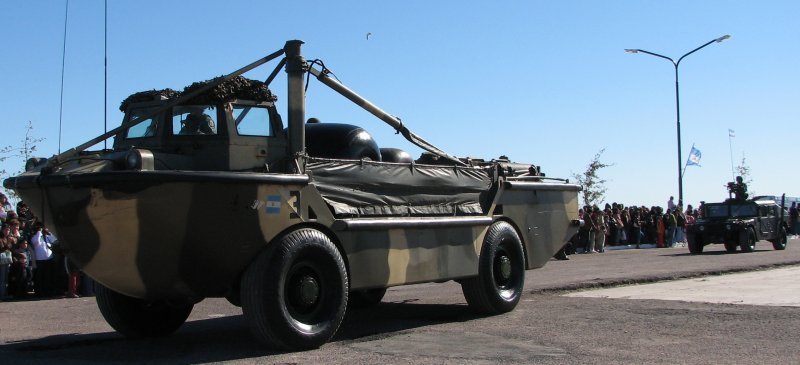|
LARC-5
LARC-V (Lighter, Amphibious Resupply, Cargo, 5 (V) ton), is an aluminium-hulled amphibious vehicle, amphibious cargo vehicle capable of transporting 5 tons. It was developed in the United States during the 1950s, and is used in a variety of auxiliary roles to this day. In addition to the United States, LARC-Vs have been used by military forces in Australia, Argentina, Portugal, the Philippines, Singapore and Iceland. Approximately 968 were made. About 500 were destroyed, most by scuttling during the American withdrawal from South Vietnam. About 200 have been retained in U.S. military service. Roughly 100 are privately owned and mostly used for tourism. Operational history The LARC-V was fielded in 1963 and were used extensively by the U.S. Army for over the beach supply during the Vietnam War. They supported the logistical and manpower build up at the start of and during the Vietnam war. Two units arrived from Ft. Story, VA. in June 1965. The 344th Transportation Company (Li ... [...More Info...] [...Related Items...] OR: [Wikipedia] [Google] [Baidu] |
Argentine Marines
The Naval Infantry Command (), also known as the Naval Infantry of the Navy of the Argentine Republic () and generally referred to in English as the Argentine marines, are the amphibious warfare branch of the Argentine Navy and one of its four operational commands. The Argentine marines trace their origins to the Spanish Naval Infantry, which took part in conflicts in South America in the eighteenth and nineteenth centuries. Argentine marines took part in various conflicts of the nineteenth and twentieth century, notably the War of the Triple Alliance and the Falklands War. The marines (represented by the 5th Naval Infantry Battalion) are considered to have been among the best Argentine combat units present in the Falklands. The most recent war in which Argentine naval infantry took part was the Gulf War of 1990. Nowadays Argentine naval infantry are frequently deployed on UN peace-keeping missions. History The Marines trace their origins in Spanish Naval Infantry, at th ... [...More Info...] [...Related Items...] OR: [Wikipedia] [Google] [Baidu] |
Amphibious Vehicle
An amphibious vehicle (or simply amphibian) is a vehicle that works both on land and on or under water. Amphibious vehicles include amphibious Amphibious cycle, bicycles, Amphibious ATV, ATVs, Amphibious automobile, cars, Duckboats, buses, trucks, Railroad car, railway vehicles, combat vehicles, and hovercraft. Classic landing craft are not amphibious vehicles as they do not work on land, although they are part of amphibious warfare. Ground effect vehicles, such as ''ekranoplans'', will likely crash on any but the flattest of landmasses so are also not considered to be amphibious vehicles. General technical notes Two main categories of amphibious vehicles are those that travel on an air cushion (Hovercraft) and those that do not. Among the latter, many extend the off-road capabilities of land vehicles to all kinds of terrain, including ice, snow, mud, marsh, swamp etc. This explains why many designs use Tracked vehicle, tracks in addition to or instead of wheels, and in som ... [...More Info...] [...Related Items...] OR: [Wikipedia] [Google] [Baidu] |
101st Airborne Division
The 101st Airborne Division (Air Assault) ("Screaming Eagles") is a light infantry division (military), division of the United States Army that specializes in air assault military operation, operations. The 101st is designed to plan, coordinate, and execute brigade-sized air assault operations that can be conducted in one period of darkness, at distances up to 500 nautical miles, to seize key terrain and hold it for up to 14 days. In recent years, the 101st was active in foreign internal defense and counterterrorism operations in Iraq, in Afghanistan in 2015–2016, and in Syria, as part of Operation Inherent Resolve in 2018–2021. Established in 1918, the 101st Division was first constituted as an airborne unit in 1942. During World War II, it gained renown for its role in Operation Overlord (the Normandy landings, D-Day landings and American airborne landings in Normandy, airborne landings on 6 June 1944, in Normandy, France); Operation Market Garden; the liberation of the ... [...More Info...] [...Related Items...] OR: [Wikipedia] [Google] [Baidu] |
Underwater Construction Teams
Underwater Construction Teams (UCT) are the United States Navy Seabees' underwater construction units numbered 1 and 2 that were created in 1974. A team is composed of divers qualified in both underwater construction and underwater demolition. Possible tasks can be: battle damage repairs, structural inspections and assessments, demolition of Waterline facility, waterline facilities or submerged obstructions, installation of submerged surveillance systems, or harbor and channel clearance. As needed, teams may test and or evaluate new or existing aquatic systems or equipment. Extending construction, whether vertical or horizontal, beyond the shoreline and waterline is their specialty. Reflecting Seabee tradition, teams are expected to execute underwater construction anywhere, anytime, under any conditions. History Almost as soon as Naval Construction Battalions were created submerged construction tasks were being brought to the Seabees. In 1942 a second class divers school was ... [...More Info...] [...Related Items...] OR: [Wikipedia] [Google] [Baidu] |




